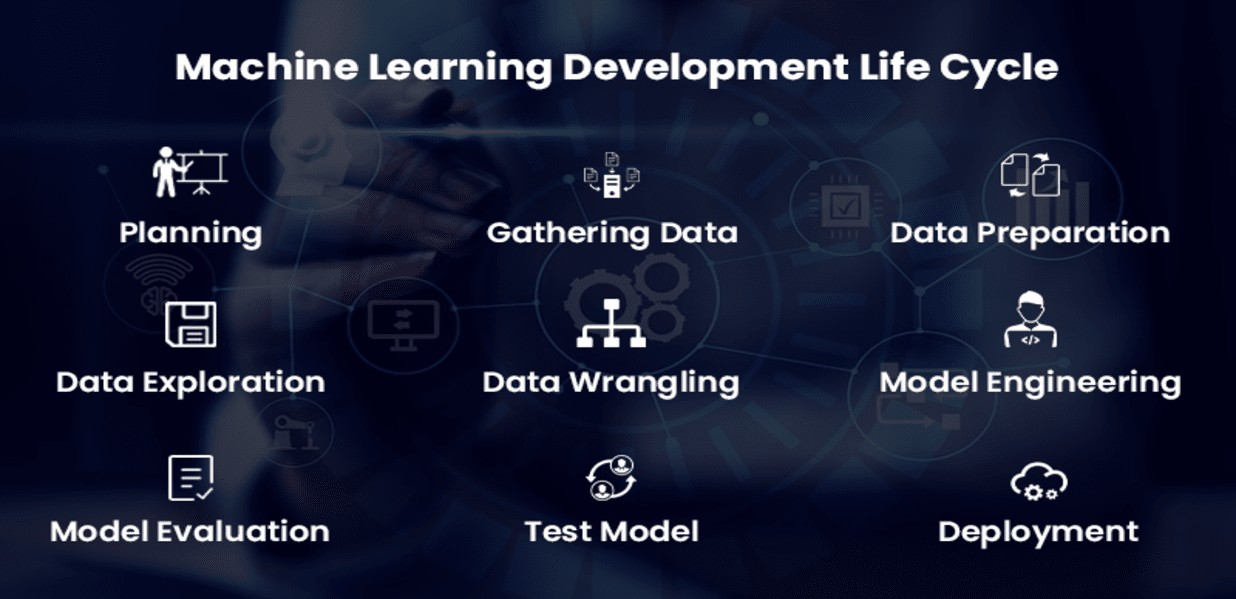9 Stages of the Machine Learning Development Life Cycle with Infiniticube
Machine Learning (ML) is a rapidly growing field of technology that is transforming the way businesses operate. It is being used to automate processes, improve customer service, and optimize decision-making. As with any new technology, there is a development life cycle that must be followed to ensure successful implementation.
In this post, we will discuss the different stages of the machine learning development life cycle and how Infiniticube can help you with each stage. We will cover topics such as data collection, feature engineering, model selection, training, evaluation, and deployment. By the end of this post, you should have a better understanding of the ML development life cycle at Infiniticube. So let's get started!
Machine Learning Development Life Cycle Stages
Planning
Planning is the first and beginning stage of the machine learning development life cycle. It is the first step in creating a successful ML project and helps to ensure that all stakeholders are on the same page. The planning phase of the ML development life cycle includes defining the goals of the project, gathering the necessary data, and selecting the appropriate algorithms and tools.
When planning an ML project, it is important to consider the objectives of the project and the resources available. This includes identifying the data sources, determining the scope of the project, and selecting the appropriate algorithms and tools. Additionally, it is important to define the timeline for the project and determine the budget.
Gathering Data
Data is the foundation of any machine learning development life cycle. It is essential to have quality data to train the machine learning models and get accurate results. Gathering Data is the second stage in the machine learning development life cycle because it provides the foundation for the rest of the process. Without data, there can be no machine learning algorithms or models. The quality of the data gathered will directly affect the accuracy and performance of the machine learning algorithms.
The data-gathering process involves collecting data from various sources such as databases, web services, text files, and more. The data should be relevant to the problem that needs to be solved. It should also be in a format that can be easily processed by machine learning algorithms.
Data Preparation
The third stage is Data preparation in the machine learning development life cycle. It involves transforming raw data into a format that can be used for analysis and modeling. This process includes cleaning, normalizing, and organizing data to make it more suitable for machine learning algorithms.
Data preparation is an important part of the machine learning development life cycle because it helps ensure that the data is accurate and consistent. Data must be prepared in a way that allows machine learning algorithms to identify patterns and relationships between different variables. Without proper data preparation, machine learning algorithms may not be able to accurately interpret the data and produce accurate results.
Data Exploration
Stage four, Data exploration is the next forward step machine learning development life cycle. It examines data sets to uncover patterns, identify outliers, and discover relationships between variables. In this stage, we identify potential problems in the data, such as missing values, outliers, or incorrect data types. Here, we also try to understand the structure of the data and identify any trends or patterns that may be useful for building a machine-learning model.
Data exploration involves various techniques, such as visualizing data, computing summary statistics, and using correlation and regression analysis. Visualization techniques can help to quickly identify patterns in the data, while summary statistics can provide a more detailed overview of the data. Correlation and regression analysis can be used to identify relationships between variables and identify potential predictors of a target variable.
Data Wrangling
Stage five is Data wrangling in the machine learning development life cycle. It is the process of cleaning, transforming, and organizing data to make it more suitable for analysis. Data wrangling is a crucial step in the machine learning development life cycle because it helps to ensure that the data is accurate and reliable.
Without data wrangling, the machine learning model would be unable to predict outcomes accurately. Data wrangling also helps to reduce the amount of time needed to build a machine-learning model. By ensuring that the data is clean and organized, the machine learning model can be built faster and with fewer errors.
Model Engineering
Stage sixth, i.e. Model Engineering of the machine learning development life cycle is a set of processes that organizations use to develop ML models. This stage in the ML development life cycle involves the development, testing, and deployment of ML models.
Model engineering is the process of designing, building, and testing ML models to ensure they are accurate and reliable. It is a complex process that requires a deep understanding of the data, algorithms, and techniques used to create the model. The goal of model engineering is to create a model that is accurate, reliable, and efficient.
Model Evaluation
The seventh stage i.e. Model evaluation can be said crucial stage in the machine learning development life cycle. It is the process of assessing the performance of a machine-learning model against a set of criteria. This evaluation helps to identify any weaknesses or areas for improvement in the model.
The evaluation process also involves testing the model on unseen data. This helps to identify any issues with the model that may not have been identified during the training process. This is important because it helps to ensure that the model can generalize well to new data.
Test Model
Testing the model is a critical eighth stage in the development life cycle because it helps to ensure that the model is accurate and reliable. It also helps to identify any potential issues or bugs that may be present in the model. Testing the model involves running it through a series of tests to check for accuracy, performance, and other metrics. This helps to ensure that the model can accurately predict outcomes and make decisions based on the data it is given.
Testing the model can be done in a variety of ways. For example, the model can be tested using a variety of datasets, such as real-world data or simulated data. This allows the model to be tested against different scenarios and conditions. Additionally, the model can be tested using different algorithms and techniques, such as supervised learning or unsupervised learning. This helps to ensure that the model can handle different types of data and make accurate predictions.
Finally, the model can be tested using a variety of metrics, such as accuracy, precision, recall, and F1 score. These metrics help to evaluate the performance of the model and provide insight into how well it is performing.
Deployment
Deployment is the final stage in the ML development life cycle and involves the process of making a model available for use in production. The ML deployment process begins with model selection. This involves selecting the most appropriate model for the task at hand based on the data available and the desired outcomes. Once the model is selected, it must be trained and tested to ensure accuracy and reliability.
The deployment process typically involves deploying the model to a cloud platform or hosting environment. This allows the model to be accessed from anywhere with an internet connection. Additionally, the model must be monitored and maintained to ensure it is performing as expected. Optimizing the performance of an ML model can help improve its accuracy and reduce the time it takes to deploy the model.
Conclusion
The Machine Learning Development Life Cycle with Infiniticube is an effective way to create and deploy ML models. We provide a comprehensive set of tools and processes that help organizations develop, deploy, and maintain ML models cost-effectively and efficiently. The nine stages of the ML development life cycle with us include the above-mentioned points. Each stage is important for the successful development and deployment of ML models. By following the ML development life cycle, organizations can ensure that their ML models are reliable, accurate, and up-to-date. And we exactly make sure to help our clients to make better decisions and achieve their desired business outcomes.
Get in touch with us right away and discuss how your next machine learning model gonna be! Our 90 days of free maintenance and monitoring services provide you with the peace of mind that your ML model is running smoothly and efficiently. With our experienced team of professionals, you can rest assured that your model is in good hands.
 June 27, 2025
June 27, 2025
 Balbir Kumar Singh
Balbir Kumar Singh
 0
0
 June 13, 2025
June 13, 2025
 Balbir Kumar Singh
Balbir Kumar Singh
 0
0









Leave a Reply